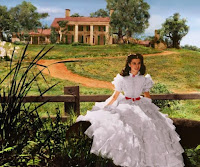“The world is perverse. And sometime perversity happens in the most beautiful places….You can still go to the American South and visit these whitewashed plantations, and a Scarlett O'Hara figure will give you a guided tour of the place, offer you lemonade or ice cool tea, and show you where the cotton was picked, as if it were Disney World.
“That is where these perverse things happened. And
that is what I wanted to show, exactly as it was. Deal with it.”—Director Steve
McQueen (12 Years a Slave), quoted in
Peter Aspden, “The World is
Perverse…Deal With It,” The Financial
Times, Oct. 4-5, 2015
In the immensely powerful medium of cinema, it has
taken a long time for the truth about slavery to seep out. Even the TV
juggernaut that the miniseries Roots became in the 1970s didn’t come
close to erasing the image left by Birth of a Nation (or, even more so, Gone
With the Wind, pictured) about the nature of the South under
slavery.
A little over six years after the premiere of the
Oscar-winning 12 Years a Slave, many of the romantic myths surrounding antebellum
culture and the Confederacy endure. We shall see if the well-publicized moves
by Hollywood’s Academy of Motion Picture Arts and Sciences to open its
membership beyond white males will corrode these misperceptions at long last.

No comments:
Post a Comment